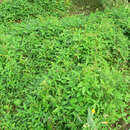Brief Summary
provided by EOL authors
Glycine max, the soybean (also soya- or soja bean, formerly classified as Glycine soja), is an annual herbaceous plant in the Fabaceae (legume or bean family) that originated in southeastern Asia (including China, Japan, and Korea) that was domesticated more than 3,000 years ago for its edible seeds and young pods. It is now the world’s most important legume crop, and the sixth of all cultivated crops in terms of total harvest, and the most widely produced oilseed, grown in diverse climates worldwide. The soybean plant, which is densely hairy on leaves and stem, can grow to nearly 2 m (6 ft) tall, although commercial varieties are more typically 0.3 to 0.9 m (1 to nearly 3 ft). Leaves are compound, with 3 leaflets. The inconspicuous, stalkless white to purple flowers are borne singly or in small clusters in the axils (where leaf meets stem). The fruit is a broad, hairy, flattened legume or pod, around 10 cm (3 in) long, yellow to brown when fully mature and dried. Pods typically contain up to 4 beans, which vary in size and color depending on cultivar (colors range from white to reddish to black). Soybean pods may be harvested when still green for use as a fresh vegetable (for example, boiled in salted water and squeezed out of the pod, in the Japanese dish know as edamame, or may be harvested when fully mature and dried, and used in numerous Asian dishes including soups, salads, and sweets. Sprouted soybeans are also commonly used as a fresh vegetable in Asian salads, or cooked in stir fries and spring rolls. Soybeans, which are high in both protein and oil, are processed into diverse food products, including soy curd and fermented soy cakes (tofu and tempeh), soy sauce, soy paste (miso), and soy milk (which is frequently used as a dairy substitute). Hydrolyzed vegetable protein is a meat substitute made from processed soybeans. Flour made from soy beans is used in numerous processed foods, as a stabilizer and to increase protein content. Soy oil is widely used in cooking (including in food products such as margarine, shortening, salad oil) as well as in cosmetic and industrial products (paints, printing inks, soaps, disinfectants, and linoleum). Soy oil is also increasingly used as a biofuel. The soy meal that remains after oil is extracted is used to make fiber, textiles, and adhesives, or as livestock feed. Soybeans and whole plants are also widely used for animal fodder and pasture, hay, and silage, as well as grown as a cover crop (green manure). Total commercial production of soybeans in 2010 was 261.6 million metric tons (mmt) worldwide, harvested from 102.4 million hectares (which comprises around 2% of the planet’s agricultural land). The U.S. was the leading producer of soybeans, producing just over one third of the world total. Other leading producers include Brazil, Argentina, and China. (Bailey et al. 1976, Ecocrop 2012, FAOSTAT 2012, Flora of China 2012, Hedrick 1919, van Wyk 2005.)
Molecular Biology
provided by EOL authors
Cultivated soybean has a genome size of 1.1–1.15 Gb (Arumuganathan & Earle, 1991). The soybean genome is a partially diploidized tetraploid. The genome is the product of a diploid ancestor (n = 11), which underwent aneuploid loss (n = 10), polyploidization (2n = 20) and diploidization (n = 20) (Singh & Hymowitz, 1988). Two genome duplications or hybridizations may have occurred (Shoemaker et al., 1996; Shoemaker et al., 2002; Blanc & Wolfe, 2004; Tian et al., 2004). The duplicated regions have been segmented and reshuffled (Grant et al., 2000; Yan et al., 2003) (CITED FROM: Shultz et al., 2006).
Brief Summary
provided by EOL authors
Cultivated soybean - Glycine max subsp. max (L.) Merr. is one of the major crops in the world and was domesticated from a wild progenitor (very likely G. max subsp. soja (Siebold & Zucc.) H. Ohashi). Many authors on basis of current evidence think that the cultivated soybean was domesticated from its annual wild relative (G. max ssp soja (Sieb. and Zucc.)) in China ≈5,000 years ago (Enken, 1959; Keen et al., 1986; Shoemaker et al., 1986; Hymowitz & Singh, 1987; Palmer et al., 1987; Doyle, 1988; Kollipara et al., 1997). The fraction of G. soja diversity retained through the domestication bottleneck is undefined. Domestication resulted in a multitude of localized Glycine max landraces (Hyten et al., 2006).

